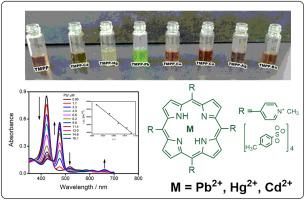Spectrochimica Acta Part A: Molecular and Biomolecular Spectroscopy ( IF 4.3 ) Pub Date : 2020-06-19 , DOI: 10.1016/j.saa.2020.118609 Gehan Sallam 1 , Shaban Y Shaban 1 , Aly Nassar 1 , Mohamed E El-Khouly 2

|
Here we report the photophysical and sensing properties of the aqueous solution of meso-tetra(N-methyl-4-pyridyl)porphyrin toluene sulfonate (TMPP) for simultaneous detection of toxic metal ions in an aqueous medium by using different physiochemical methods such as UV–vis absorption, steady state and time resolved fluorescence, stopped flow, and cyclic voltammetry. The steady-state absorption and fluorescence spectra in organic solvents (EtOH, DMSO, DMF, MeOH and ACN) showed the formation of monomer form (λmaxabs = 426 nm and λmaxflu = 654 and 715 nm). In THF and water, different spectral features were recorded suggested the formation of aggregated forms in both solvents. The formation of aggregated form in water was confirmed by recording the remarkable fluorescence quenching of the singlet excited TMPP with increasing the concentrations of TMPP. In cationic micelles (CTAB), both the absorption and fluorescence spectra were significantly decreased with increasing the concentrations of CTAB with a break at CMC value at 6.0 × 10−5 M. In an anionic micelle (SDS), the CMC value was found to be 1.0 × 10−4 M. Upon interacting with different metal ions, the absorption and fluorescence spectra of TMPP showed different features depending on the metal ions. While the optical studies of TMPP showed no significant interaction in the presence of Mn+2, Co+2, Ba2+, and Ni+2, TMPP showed that it can function as a single optical chemical sensor for the toxic metal ions in water, particularly Hg+2, Pb+2, Cu+2, and Cd+2 ions.
中文翻译:

水溶性卟啉作为光学传感器,用于检测水性介质中的有毒重金属离子。
这里,我们报告的光物理和水溶液的传感特性内消旋-四(ñ -甲基-4-吡啶基)卟啉甲苯磺酸盐(TMPP),用于在水介质中的有毒金属离子的同时检测通过使用不同的物理化学方法,如紫外–吸收,稳态和时间分辨荧光,停止流动和循环伏安法。在有机溶剂(EtOH,DMSO,DMF,MeOH和ACN)中的稳态吸收和荧光光谱表明形成了单体形式(λmax abs = 426 nm和λmax flu = 654和715 nm)。在THF和水中,记录了不同的光谱特征,表明在两种溶剂中均会形成聚集形式。通过记录单峰激发的TMPP随着TMPP浓度的增加而显着的荧光猝灭,证实了在水中形成聚集形式。在阳离子胶束(CTAB)中,随着CTAB浓度的增加,吸收光谱和荧光光谱均显着降低,并且CMC值在6.0×10 -5 M时出现断裂。在阴离子胶束(SDS)中,发现CMC值为1.0×10 -4 M.与不同的金属离子相互作用后,TMPP的吸收光谱和荧光光谱显示出不同的特征,具体取决于金属离子。尽管TMPP的光学研究表明在Mn + 2,Co + 2,Ba 2+和Ni +2的存在下没有显着的相互作用,但TMPP表明它可以作为水中有毒金属离子的单一光学化学传感器,尤其是Hg +2,Pb +2,Cu +2和Cd +2离子。











































 京公网安备 11010802027423号
京公网安备 11010802027423号